Yamaha YXZ
Fuel System
Install Guide
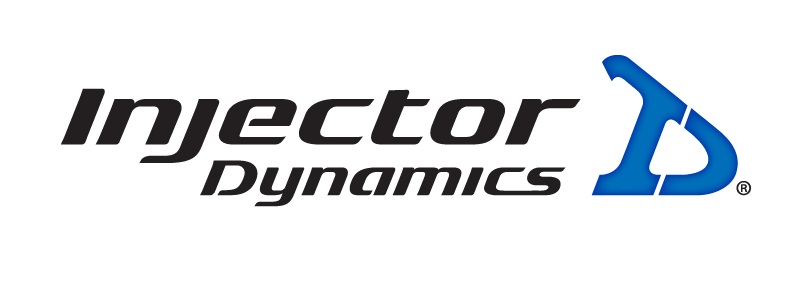
Justin Shriver
Updated on August 2, 2024
Contents
Application Notes
Supported models: 2016+ Yamaha YXZ 1000 (all trims)
The vehicle shown in this document is a modified 2021 Yamaha YXZ 1000R. Your vehicle could have parts that may or may not be present in the pictures. The pictures are meant to be a reference only. If you have any questions regarding your installation, please reach out to T1 Race Development at support@injectordynamics.com.
Item List
|
17+ Yamaha YXZ FDM Components |
||
|
Item # |
Description |
Qty |
|
1 |
Yamaha YXZ Fuel Rail |
1 |
|
2 |
Pressure Regulator Assembly |
1 |
|
3 |
M5 x 25mm Socket Head Flange Bolt |
2 |
|
4 |
06 ORB to 06 ORB Coupler |
1 |
|
5 |
90° 04 AN Bulkhead Fitting |
1 |
|
6 |
04 AN Bulkhead Nut |
1 |
|
7 |
04 Stat O Seal Washer |
1 |
|
8 |
7/16″ Stainless Steel Washer |
1 |
|
9 |
4mm Wye Barb Connector |
1 |
|
10 |
4mm Black Silicone Hose (4″) |
1 |
|
11 |
4mm Black Silicone Hose (12″) |
1 |
|
12 |
FDM Assembly |
1 |
|
13 |
Tube Mount |
1 |
|
14 |
M6 Hardware |
4 |
|
15 |
06 AN E85 Rated Hose (72″), Straight and 180° Crimp Ends |
1 |
|
16 |
06 AN E85 Rated Hose (32″), 90° and 120° Crimp Ends |
1 |
|
17 |
06 AN E85 Rated Hose (29″), Straight and 90° Crimp Ends |
1 |
|
18 |
04 AN E85 Rated Hose (72″), 45° and 120° Crimp Ends |
1 |
|
19 |
90° 5/16″ Female EFI to 06AN Male |
1 |
|
20 |
06 ORB Male to 06 AN Male |
5 |
|
21 |
06 ORB Male to 04 AN Male |
1 |
|
22 |
Wire Harness |
1 |
|
23 |
Fuse Holder Assembly |
1 |
|
24 |
Ring Terminal |
2 |
|
25 |
Metal Butt Splice |
2 |
|
26 |
Insulated Butt Splice |
1 |
|
27 |
Heat Shrink |
2 |
|
28 |
11″ Cable Ties |
10 |
|
29 |
3″ Miniature Cable Ties |
4 |
Fuel Rail + Regulator Kit
Remove Fuel Pump
- Remove the passenger seat cushion and unfasten (4) bolts shown with red arrows in figure 1 to remove the seat back.
- Remove center console covers shown in figure 2.
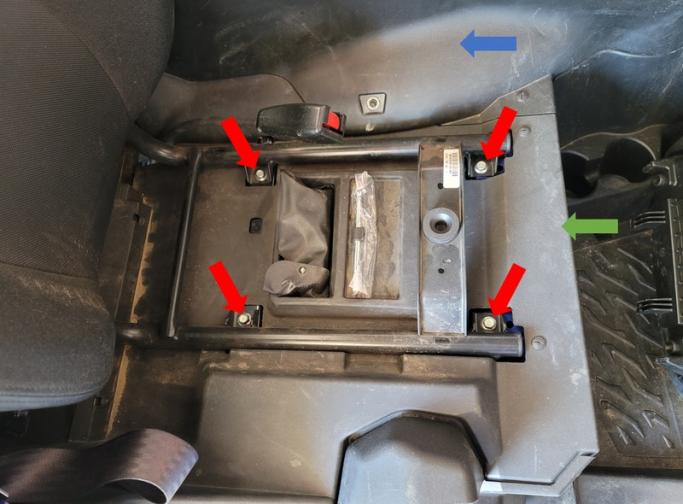
Figure 1: Seat Hardware and Panel Reference
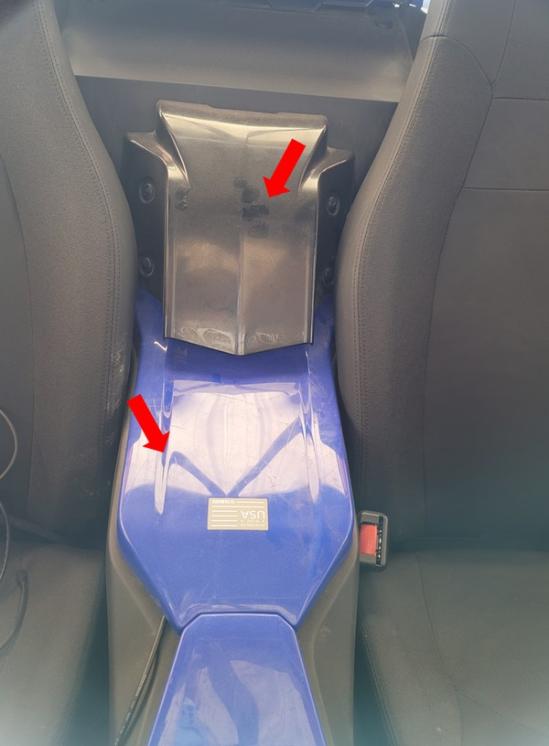
Figure 2: Center Console Cover Reference
- Remove the passenger side tunnel panel pointed out by the blue arrow in figure 1.
- Remove the gas cap and lower side panel shown in figure 3. Reinstall gas cap.
- Remove the seat bottom cover panel pointed out by the green arrow in figure 1.

Figure 3: Lower Side Panel Reference
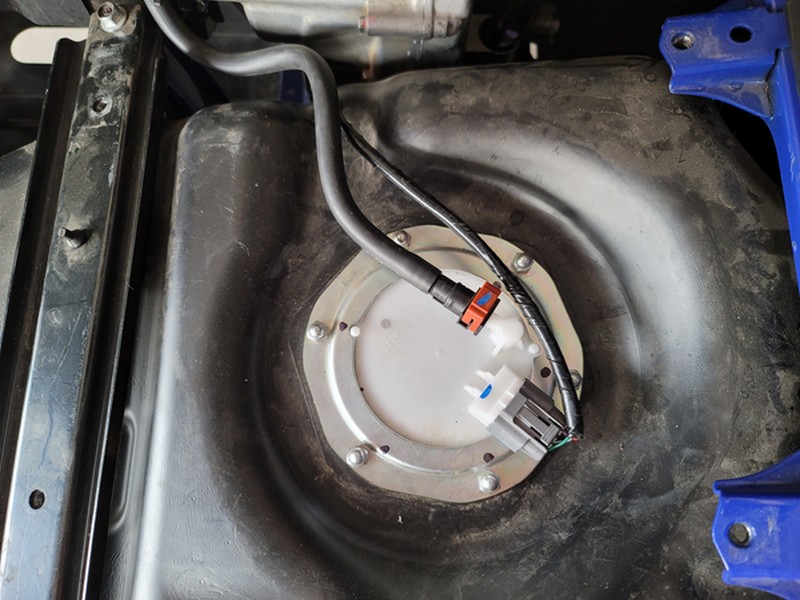
Figure 4: Pump Basket Reference
- Disconnect the power connector and crank the engine to bleed fuel pressure. Disconnect the battery.
- Disconnect the fuel line from the pump basket. There will still be some fuel left in the fuel line.
- Mark the location that needs to be drilled for the return line bulkhead fitting. (Refer to figure 5)
- Remove the six crown nuts to remove the retaining plate and lift the fuel pump assembly out of the tank (drain as much fuel back into the tank as possible).
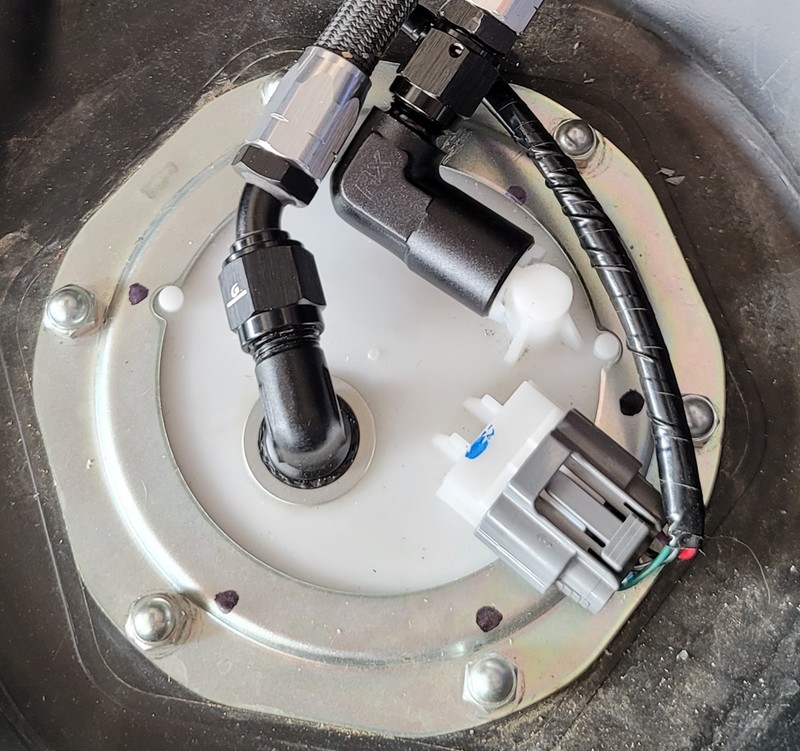
Figure 5: Return Line Location
Modify Fuel Pump Basket for Return Line
- Drill a 7/16” hole where the mark was made in the previous step. A Unibit step drill is recommended but it is also possible to start with a smaller drill bit and step up to a 7/16” bit.
- Install the 90° bulkhead fitting using the stat-o-seal on top of the pump basket. Refer to Figure 5.
- Install the EFI adapter onto the outlet of the fuel pump by removing the plastic clip from the adapter and installing it onto the outlet of the pump basket first. After the plastic clip is seated correctly, press on the metal portion of the adapter. Pull on the adapter to ensure proper installation. Use figure 6 as a reference.
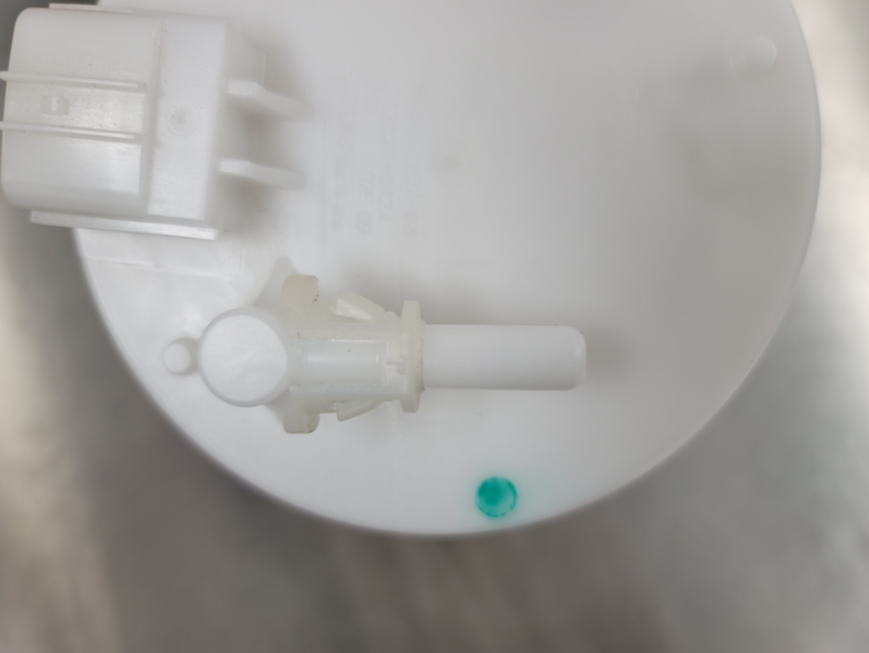
Figure 6: EFI Fitting Reference
- Reinstall fuel pump assembly into the fuel tank. Use figure 5 as a reference for all connections.
Install Fuel Rail, Injectors and Regulator
- Remove the engine cover and all 4 side covers identified in figure 7.

Figure 7: Rear Panel Reference
- Remove the driver seat using the same steps as the passenger seat.
- Remove the firewall panel located behind the seats.
- Remove the air box. Make sure to disconnect the electrical connector and all hoses.
- Disconnect injector electrical connectors.
- Disconnect the fuel line from rail.
- Remove the (2) M5 bolts to uninstall the fuel rail and injectors. Make sure to set aside the lower factory seals because they will be reused.
- Install the -6 ORB fittings. Use figure 8 as a reference.
- Install the -6 ORB to -6 AN fitting on the inlet of the rail towards the front of the vehicle.
- Install the -6 ORB swivel fitting on the outlet of the rail towards the rear of the vehicle. The non-adjustable side of the swivel fitting needs to be installed into the rail.
- Install -6 ORB to -6 AN fitting into the bottom of the regulator housing.
- Thread on the regulator housing to the swivel fitting until the threads bottom out, then back out one turn. Do not tighten the lock nut.
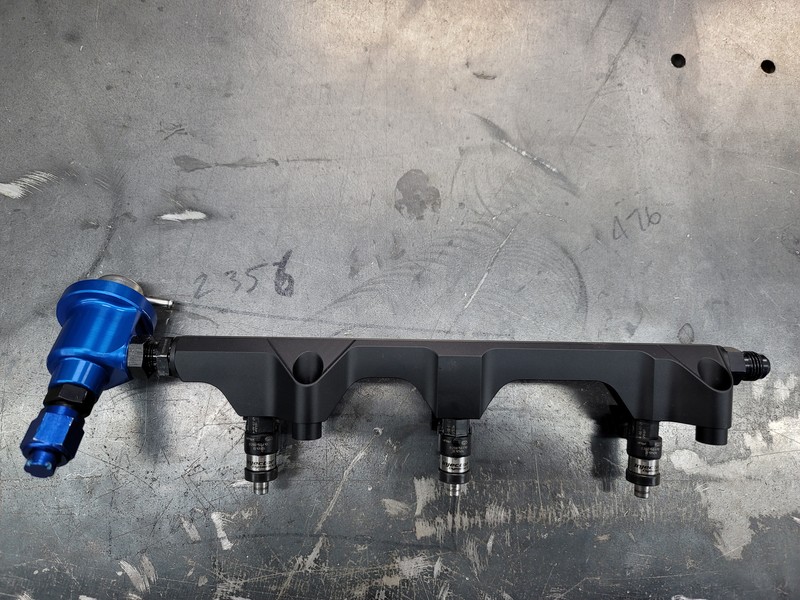
Figure 8: Rail Assembly Reference
- Install the ID injectors into the fuel rail (Apply some grease on all O-rings)
- Install fuel rail and injectors onto throttle body ensuring to properly seat the bottom of the injector on the factory cushions (Take care to not over tighten bolts).
- Tighten the lock nut to the regulator housing. Use figure 9 as a reference to the regulator housing orientation.
- Connect the injector connectors using the supplied electrical adapters.
- Push on the supplied long 4mm vacuum hose onto the pressure regulator barb.
- Tie into the factory vacuum line:
- Remove the hose from the rear pressure sensor show in figure 10 and push on the supplied short 4mm hose trim.
- Use the supplied 4mm Y connector to connect the 3 vacuum hoses. Use figure 10 for reference. Trim any excess length.
- Secure cable ties on all hose ends.

Figure 9: Regulator Orientation Reference
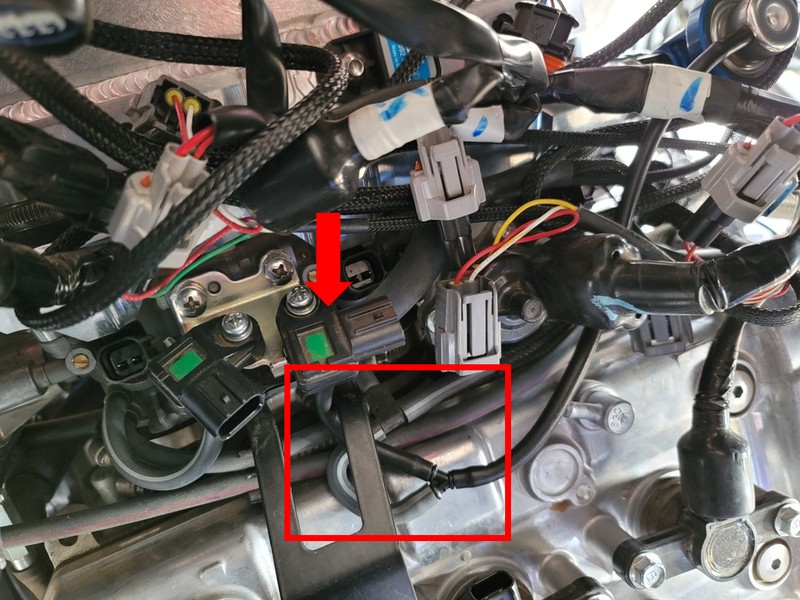
Figure 10: Vacuum Plumbing Reference
FDM Install
Mounting the FDM
- OPTIONAL – In order to make the FDM installation easier, remove the driver seat and firewall panel. This will give more access to the tube that the FDM will be mounted to.
- Using the supplied tube clamp and M6 hardware, install the FDM as seen in figure 11. Ensure that the FDM will not rub on the firewall panel.
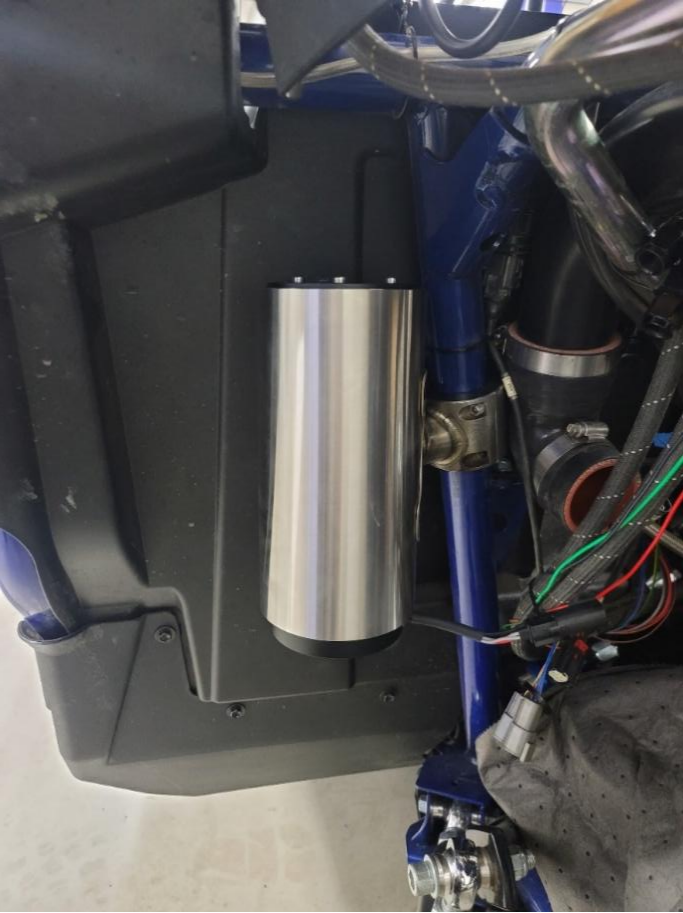
Figure 11: FDM Mounting Reference
Routing and Securing Fuel Lines
- Remove factory fuel line from vehicle.
- Install the ORB adapter fittings into the top of the FDM. Use figure 12 to reference port numbers. Ensure hoses are not rubbing on adjacent fittings. Take caution to not rotate the top cap while tightening.
- Port 1 – 6AN to 6 ORB fitting. Pump feed to rail Inlet (-6 hose with 120° fitting)
- Port 2 – 4AN to 6 ORB fitting. Return to OEM fuel tank (-4 hose with 120° fitting)
- Port 3 – 6AN to 6 ORB. Pump feed from OEM fuel tank (-6 hose with 180° fitting)
- Port 4 – 6AN to 6 ORB. Return from fuel rail (-6 hose with 90° fitting)
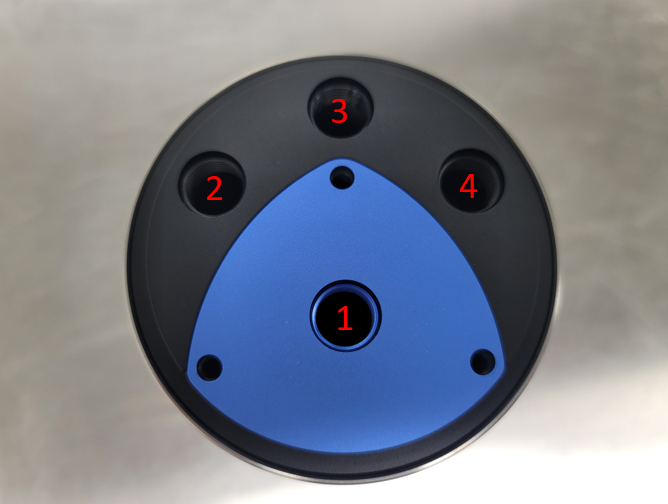
Figure 12: FDM Port Reference
- Starting with the 72” -6 feed line (longest), connect the 180° fitting to port 3 on the FDM. Use figure 13 as a reference for the hose routing. Connect the straight connector to the EFI adapter on the OEM fuel pump.
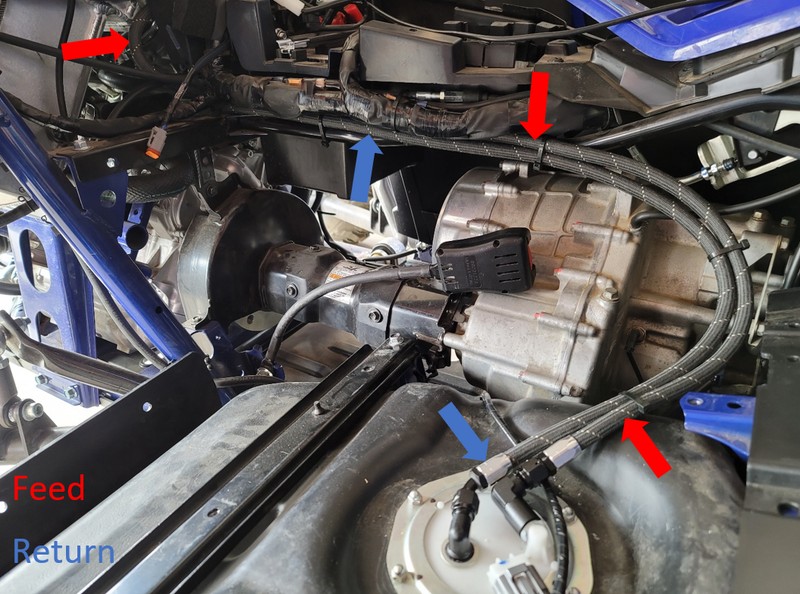
Figure 13: Fuel Line Reference
- Connect the 120° fitting of the -4 return hose to port 2 on the FDM. Route along the previously routed -6 hose and connect the 45° fitting to the return fitting on the OEM fuel pump.
- Connect the 120° fitting of the 32” -6 hose to port 1 on the FDM. Route the hose along the firewall and connect the 90° fitting to the fuel rail.
- Use the provided cable ties to secure the fuel hoses together and along the center console rail as shown in figure 13.
- Connect the 90° fitting of the remaining -6 hose to port 4 on the FDM. Route along the frame tubing as seen in figure 14 and connect the straight fitting into the bottom of the regulator.
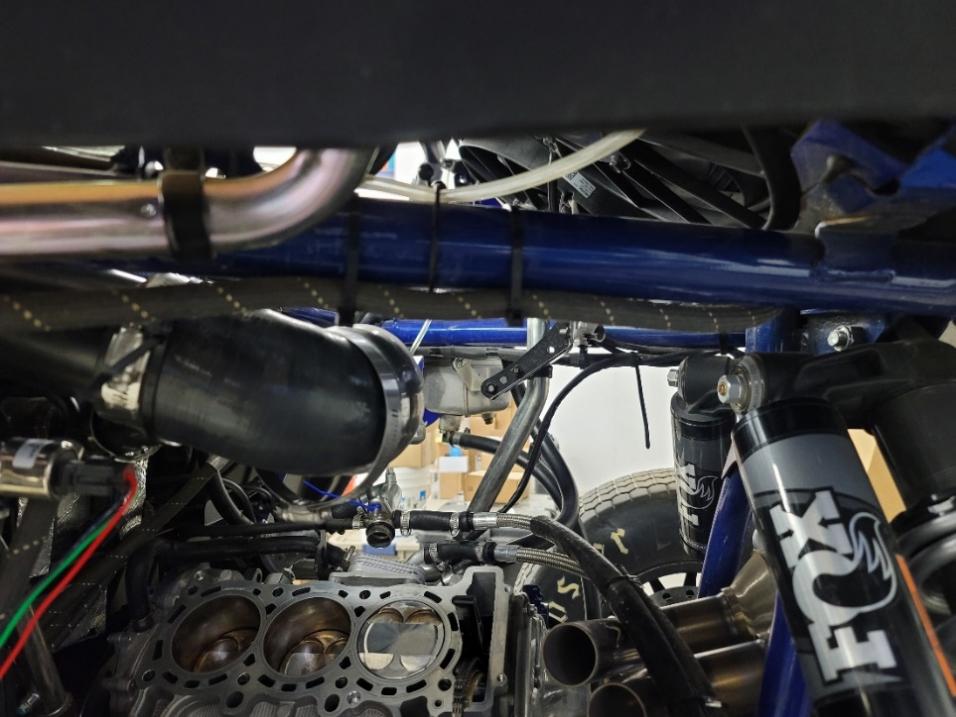
Figure 14: Fuel Line Reference
FDM Wiring
- Run the electrical harness along the fuel hoses into the center console. Route the red and black wires to the battery and the two gray wires to the OEM fuel pump. Cut off excess wire.
- Cut the fuse holder wire loop to your desired leg lengths. Using the blue supplied butt splice, connect the red wire from the FDM to one of the legs on the fuse holder. Crimp a ring terminal to the other leg of the fuse holder.
- Crimp the other ring terminal to the black wire from the FDM.
- Using the metal butt splices and heat shrink, splice the two gray wires from the FDM into the OEM fuel pump power (red with blue stripe) and ground (black with ***). It does not matter which gray wire is hooked to the OEM pump power or ground.
- Connect the red and black wire’s ring terminals to the battery.
- Secure all the wires with cable ties.
- With the electrical connector to the FDM unplugged, prime the fuel system to fill the FDM.
- Check for leaks.
- Connect the FDM electrical connector and prime the fuel system. Listen for the pump to turn on and look for the blue LED on the underside of the FDM.
- Check for leaks.
Reinstall Air Box
- Reinstall the airbox in the reverse order that it was removed.
Flash ECU
- Generate ECU data by using the online generator located on the Injector Dynamics website at http://injectordynamics.com/utv/ and follow the directions to make the changes in the calibration.
- Once the ECU flash is complete, start the vehicle ensuring that there are no leaks in the fuel system (Always have a fire extinguisher close by).
Reinstall All Remaining Parts
- Once you have ensured there are no leaks, reinstall all body panels and seats in the reverse order of removal.
